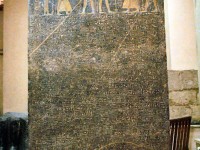
A candle inside the Holy Sepulcher
These two chapters are loaded. First, we encounter the third member of the Unholy Trinity of antichrists in the Book of Mormon. First was Sherem (Jacob 7), then Nehor (Alma 1), now Korihor. Continue reading
Historian of Religion, Science, and Biblical Interpretation


A candle inside the Holy Sepulcher
These two chapters are loaded. First, we encounter the third member of the Unholy Trinity of antichrists in the Book of Mormon. First was Sherem (Jacob 7), then Nehor (Alma 1), now Korihor. Continue reading

An example of Egyptian history-writing, the Merneptah stele. Public domain.
Historiography is the study of how history is written. For many people today, history has become journalistic, a simple retelling of “the facts about the past,” but history and history-writing is, in fact, far more complex than that. (See here for some Ensign articles on it.) Continue reading
Alma 17 begins with a chance meeting between Alma and the sons of Mosiah, and then we get a 14 year flashback.
 These chapters are the violent dénoument of the Ammonihah story. Grant Hardy cogently points out how this story with Alma/Amulek parallels an earlier story with Abinadi. Continue reading
These chapters are the violent dénoument of the Ammonihah story. Grant Hardy cogently points out how this story with Alma/Amulek parallels an earlier story with Abinadi. Continue reading

My picture, from the Kidron Valley.
Once again, the lesson and chapter divisions cut across the 1830/original chapter divisions, breaking up logical units. In particular, today’s chapter 12 extended into chapter 13:9, where it terminates appropriately with an “amen.” Then a new section began in 13:10-15:19. It is after 13:10 that Alma transitions into speaking about Melchizedek and high priests, which I shall take up next week. (Teaser: I think Alma’s invocation of high priests is a direct response to the objection that the tree of life is blocked by cherubim and a flaming sword.) Continue reading


Good Shepherd. Public domain, from wikipedia.
Alma has divested himself of the judgeship to go on a mission of sorts, to his own people, and stir them up in the ways of remembrance. These three chapters were also individual units in the 1830, so let’s look at what they contain. Continue reading
Today we move into the Book of Alma.
The stories of Alma Sr. and Alma Jr. are a major focus of the Book of Mormon; If we start in Mosiah 17, where Alma first appears, and count through the end of the Book of Alma, it’s roughly 40% of the entire Book of Mormon, by wordcount. (I generated this using Bibleworks 10, though it is off by a bit, because my electronic text doesn’t include original chapter or book headings. Total Book of Mormon count is roughly 267,000 and Mosiah 17-Alma is roughly 99,400.)
Why did Mormon choose to spend so much time on the period of the Almas, and so little on, say, 4th Nephi? Is it source dependant? (Mormon can’t write what he doesn’t have sources for.) Is it something about the material that Mormon found particularly useful or relevant?

My picture, from the Kidron Valley.
This lesson has us jump to Alma’s retelling of his experience being unconscious for three days, in Alma 36. The story of Alma the Younger is actually told in three places, not just two: Mosiah 27:8-37 (roughly contemporary), Alma 36 (Alma jr. recounting to his son Helaman), and Alma 38:6-8 (Alma Jr. recounting to his son Shiblon.) Continue reading

My bookshelf
Latter-day Saints have a thing about Doctrine, with a capital D. We try to define it, we argue about it, we prioritize it. We even misquote scripture which supposedly says “bearing down in pure doctrine” (Alma 4:19), when it actually says “pure testimony.” “Pure doctrine” is not a scriptural phrase, and I’m not even sure what it means. We tend to read scripture looking for doctrine. Sometimes, because of cultural expectations about how to identify doctrine, we can’t see it when it’s right in front of us. Continue reading
I want to plug Book of Mormon Central for collating published scholarship on lessons- See here for today’s links and summaries. (What they have is partly based on my own old work.) Most of today’s chapters involve Abinadi, his preaching, his words. We tend to read our scriptures without regard for where they came from, or how we got them, but that kind of context is often important. We tend to read direct speech (e.g. “And Abinadi said…”) as verbatim records, but should we? And what difference does it make? Continue reading
Recent Comments